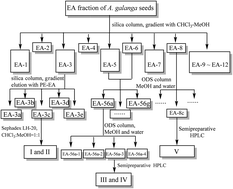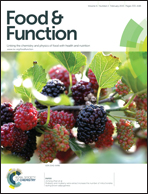Isolation and identification of ingredients inducing cancer cell death from the seeds of Alpinia galanga, a Chinese spice
Abstract
This study was carried out to isolate ingredients from the seeds of a Chinese spice (Alpinia galangal) and to evaluate their cytotoxic activity on cancer cell lines. Isolation and purification of the phytochemical constituents were conducted using silica gel, Sephadex LH-20 and ODS columns. After extraction using 95% ethanol, the total extracts were re-extracted, resulting in petroleum ether (PE), ethyl acetate (EA) and water fractions, respectively. Activity tests showed that the EA fraction exhibited obvious (p < 0.05) protective effects on H2O2 damaged PC-12 cells at 20 μg mL−1, and showed much higher (p < 0.05) cytotoxic activity on cancer cell lines than other fractions. Five compounds, 1′-S-1′-acetoxyeugenol acetate (I), 1′-S-1′-acetoxychavicol acetate (II), 2-propenal, 3-[4-(acetyloxy)-3-methoxyphenyl] (III), isocoronarin D (IV) and caryolane-1, 9β-diol (V), were obtained from the EA fraction and identified by HPLC, UV, MS, and NMR spectroscopic analyses. Compounds III and V were isolated from A. galangal for the first time. Moreover, compounds I, II, IV and V were the main active ingredients for inducing death of the tested cancer cells, and their IC50 values ranged from 60 to 90 μg mL−1, indicating that these compounds possessed a wide anti-cancer capability. Therefore, A. galangal seeds could be a potential source of healthy food for tumor prevention.


 Please wait while we load your content...
Please wait while we load your content...